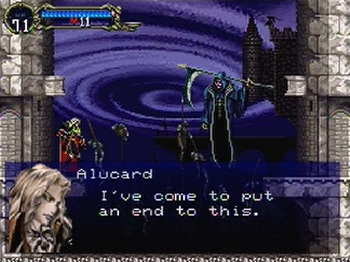
Castlevania: Symphony of the Night strikes the perfect balance of story and gameplay with an absolute minimal number of brief dialogues between characters.
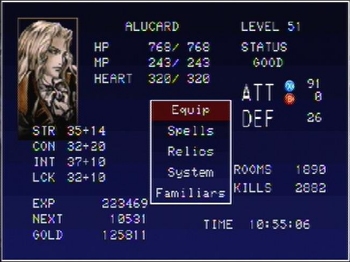
While flirting with RPG elements, Castlevania: SotN mercifully keeps Alucard’s maintanence short and simple, letting you get back to actually playing the game.

Symphony of the Night abandons previous Castlevania’s level structure in favor of Metroidesque exploration, and it always amused me how similar SotN’s white outlined blue boxy maps are to Super Metroid’s maps.
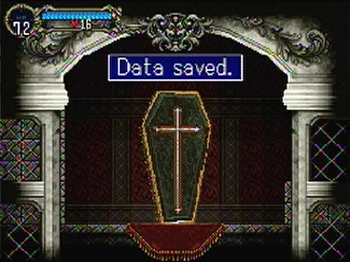
Considering you’re no more than two minutes away from a save at any given time, they could’ve gotten away with at least a few freakishly difficult fights.
Review by Jay Wilson I’ve always maintained that video games have retarded stories—even the so-called story-driven RPGs (good God, especially the so-called story-drive RPGs.) Of course, there are (three or four) individual exceptions, but for the most part game stories suck. They just do. I say this not out of contempt for video games. Believe it or not, I say it with affection. Games really aren’t geared for telling stories. Case in point: the more they try, the more they become like movies (with cut scenes) or books (in-game text ... kinda the precursor to cut scenes). No, games are geared for playing. So to hell with story. The prime example? Castlevania: Symphony of the Night. The plot? A flimsy pretext predicated on Konami’s decision to make another sequel in an established game franchise. The voice acting? We’re talking 1997, so wooden, stilted, and laughable. But the moment Richter Belmont grabs his whip and goes head to head with a teleporting Dracula to the epic “Dance of Illusions” music, I defy you to find someone who cares about such silly aesthetics as “story.” What aesthetics really matter (if any)? Visual and audio, as we’ll be looking at and listening to this thing while wandering around the demon castle for hours at a time, kicking ass, and chewing bubble gum. And Symphony of the Night looks, sounds, feels, and, yes, plays like a dream. A dark, yet beautiful and haunting dream. Ayami Kojima's work on Symphony of the Night and later Lament of Innocence transcends pretty accompanying imagery for the cover and booklet, and went on to provide the definitive “look” of the entire Castlevania franchise. Her character illustrations, which appear in-game accompanying dialogue boxes in the handful of story moments, includes exquisitely detailed renders featuring rich colors that somehow (almost paradoxically) give off a dark and gothic vibe. Just look at the vibrant blue sheen on Richter’s jacket, the strangely soothing earth tones in Maria’s outfit, and the eerie blood-crimson against inky blackness of Dracula’s cape. Elegant and classy, but at the same time tragic, bleak, and curiously seductive—all classic Castlevania themes. Kojima is not only one of my favorite “game artists”, rather one of my favorite artists, period. I simply adore her work. The in-game sprites, though nowhere near as detailed as Kojima’s full blown illustrations, do miraculously capture the tone and essence of their full scaled counterparts, and they bring their own layers of details with them. I love the attention to detail like how when Alucard starts moving, he’s briefly followed by a trail of shadow doubles (and just watch how smooth and fluid his run animation is). Little touches like when you use his back dash, a small dust trail rises up from his feet. And when his magic meter replenishes, a blue aura briefly radiates from Alucard letting you know it’s fully charged. Press up on the directional pad, and watch Alucard stand up straight and strike a Bela Lugosi pose with his cloak. A plethora of creative and colorful enemies attack in a surprisingly high number of ways from skeletons who toss bones at you, to the staple medusa heads that fly across the screen in a wave pattern, to the Blue Venus Weeds which sprout an array of pointed vines from the ground while throwing a second array of thorns across the screen (side note: God I hate those frickin’ things.) Even their death animations are varied and fun to watch—bursting into simple flames like the normal zombies early on, spouting a fountain of blood like the aptly named “blood zombies” a bit later, to falling apart in pieces to a fireworks display of mini-explosions like the Axe Knights. And the backgrounds ... Symphony of the Night’s backgrounds are alive with wonderful little touches. Walking up the steps to Dracula’s throne room, notice the 3D clocktower in the background which changes perspective as you move across the screen. In the corridors of the chapel, look at the flowing other-worldly clouds outside. And heading to the Outer Wall (which sometimes, itself, features a neat fog effect), as you pass through that long long (long) corridor in the Marble Gallery, check out the giant floating eyeballs through the distant glass doors, watching you. In the library, watch how 3D books fly off the bookshelves, grow to giant proportions, and attack. Plain and simple, Symphony of the Night is still a pleasure to look at which is more than pretty much any 3D game from 1997 can claim. 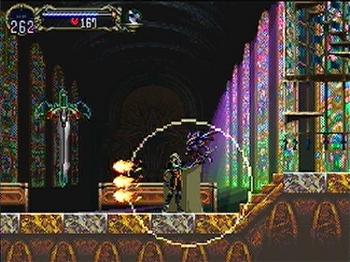
The stained glass windows in the background are actually done in 3D so the perspective changes accordingly as you move about the room. Very cool.

If you didn’t have Power of Mist and Soul Steal by the time you get to the Blue Venus Weed (a normal enemy in the inverted castle), she’d be harder than 90% of the bosses.

I love how bosses in the first castle become normal enemies in the inverted castle. It’s great at showing how much more powerful you are towards the end.
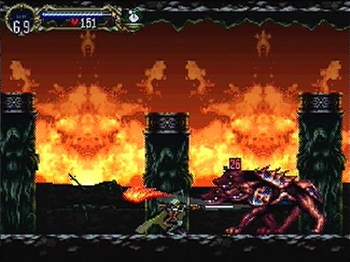
A minor annoyance: you can take down way too many bosses by simply ducking and attacking, and most of the time their tactics don’t really evolve the closer they come to dying.
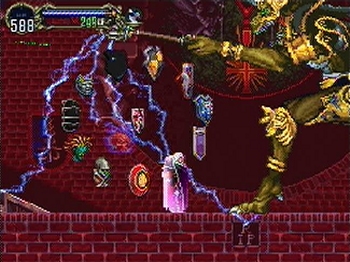
My single real complaint against SotN: Galamoth. He either takes ten seconds to beat using the Shield Rod+Alucard Shield trick or too God damn long any other way.
On the audio end of the spectrum, Michiru Yamane’s music matches Kojima’s artwork point-by-point with a diverse score that finds just the right tone for each section of the castle(s) and just the right thrill for each battle. For example: “Wood Carving Partita” which plays during exploration of the Long Library. As its name implies, the piece has a very classical dignified sound with a lively harpsichord leading an equally lively accompaniment of stringed instruments. Slightly subdued with just enough of a bounce, it evokes the spirit of formal parties the aristocratic elites in powdered wigs would hold. Contrast that with “Festival of Servants”, one of the boss battle themes, whose fast and furious “machine gun” drums and high octane guitars/synths would feel right at home at a heavy metal concert. I particularly like how the main leitmotif (first played by a guitar, then later with a synth and then both) sound fragmented and incomplete which instills a sense of unease, further intensifying an already relentless rhythm. At the same time, Festival of Servants isn’t overly dark. That main leitmotif rises up the octave (in general) which gives it a somewhat uplifting sound, and along the way it oscillates between higher notes and lower notes during its overall ascent which gives it just a hint of bounce and keeps it fun (it’s still a game after all.) Game music, particularly of that era, often struck me as simplistic, overstated, and uninteresting. Part of it was the technical limitations of the hardware and part of it was the constraints which the music had to fit—limited time for theme development before the track had to loop and replay infinitely. This lead to tracks sounding like a collection of single-purpose themes (the battle theme, the happy theme, the sad theme, etc). But listen to Michiru Yamane’s music. It drips atmosphere appropriate to its place in the game, but it goes far beyond that with both nuance and a narrative quality. Take for example “Dracula’s Castle”, which we hear upon first taking control of Alucard at the start of the game. It begins ominously with sounds of wind, echoing celestas, various distortion effects, a few hints of guitars, and evolves into what I consider to be Alucard’s theme—upbeat, but curiously leisurely (Alucard has a mission, but he is immortal so he knows patience); and reluctantly heroic (while his mission is benevolent, he is the son of Dracula and never would consider himself anything but a curse the world would be better off without.) But keep listening. Listen to the journey this music takes us on which mirrors the classical narrative arc—listen to the story it tells. From that ominous intro, it goes on to explore the main motifs and musically introduces us to our protagonist. It then organically flows into a brief escalation and climax (I adore the bass guitar here, about a minute in) which perfectly reflects the dark protagonist’s conflict. Then comes a moment of pure brilliance: it enters a magical calm where the percussion fades out, and the wind effects and celesta returns to provide an appropriate bookend. And finally it gears up to repeat. All in the short span of 105 seconds. Unlike most game scores, Yamane’s music really does feel like they need that infinite loop so the listener can pick up on and fully appreciate everything that’s there. And now for the game play. It goes without saying the controls are tight and responsive, allowing the player to navigate the twin castles and battle Dracula’s minions because nothing is more frustrating than playing a game with crappy controls (especially if said game has insta-death pits/spikes which, by the way, SotN does not have). Strangely enough, the controls gets me into trouble sometimes. For example, Alucard can run backwards (not back dash) with his shield out for a few steps before turning around which is actually very useful in tight spots (like against those God damn Blue Venus Weeds where you’re surrounded by walls of vines with incoming thorn projectiles). And while Alucard can perform the maneuver, I can’t seem to get the timing down. In addition to running, jumping, backdashing, and attacking (with both a primary weapon and the classic Castlevania sub-weapons) we get into what makes Symphony of the Night so unique: Alucard, his spells, and his many forms which are insanely powerful. Spells are performed via directional input/button press combination, and the first few spells seem useful and balanced enough—Dark Metamorphisis which lets Alucard regain a few points of health from any enemy that bleeds (of which there’s not a whole hell of a lot, actually). It’s neat, appropriate, and requires tactical use. Also Hellfire which allows Alucard to teleport a brief distance and throw a few fireballs (exactly like his father in the opening battle against Richter—a very cool touch, I might add). There’s a set distance Alucard can teleport and he can’t change platforms. The fireballs are powerful and Alucard is invincible until after he unleashes his projectiles, but it’s a bit clunky and unwieldy to use against agile enemies (or enemies on a different platform). I usually only use it as an evasive maneuver early in the game (if at all). From there, the spells go into God mode with the ability to summon a single spirit which flies around the screen and delivers one or two hits to a random enemy. This allows Alucard to camp out at a safe distance and summon spirits one after another. For those who don’t feel like waiting, there’s a powered up version which summons five—yes five—of these things. Wait, it gets worse. Alucard also has Soul Steal which hits everything on the screen (including hidden blocks concealing secret passages, by the way) and it heals Alucard. Those Blue Venus Weeds I so hate? Yeah, I can Soul Steal them to death, but that feels like cheating. 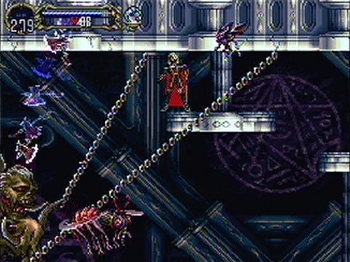
If you have enough hearts, you can beat Beelzebub exclusively by raining axes down on his head, taking mist form to avoid his fly minions.

It doesn’t matter how many enemies nor how powerful said enemies are, while your magic meter holds out Mist Form beats everything—and I mean absolutely everything.
Across the game, Alucard will gain the ability to take on new forms including a wolf (great for getting across long straight uninterrupted corridors quickly because Alucard is so damn slow) and bat (because when has flying ever not been cool?) And then comes the uncontested greatest ability in video game history: Form of Mist. That’s right, Alucard can become mist and (eventually) fly around. How badass is powered up Mist Form? I wish there were insta-death pits/spikes—yes, the bane of my video game existence—I wish they were here just so I can laugh in their faces as I float past completely and totally invincible. Full screen attacks such as Richter's Holy Cross? Good luck hitting air, pal. Can this get any more Godlike? Yes, yes it can. Alucard can eventually become poisonous mist and kill basically everything while absolutely invincible. The D&D Dungeon Master part of me wants to complain how overpowered Form of Mist and its variants are, but I dunno, in a way it really does feel like that once in a lifetime opportunity. When else is absolute immunity and total freedom of movement going to be a single button press away? When else are you going to be able to enter a tower jam packed with enemies and say “to hell with this”, turn into a cloud, and safely fly past freaking Armageddon? It really does feel like Castlevania: Symphony of the Night is the only game that could have gotten away with an ability this game-breakingly powerful. For one, how many game characters would this power be appropriate for? And two, challenging or not, Symphony of the Night still looks, sounds, and plays like a dream. And last I checked, having Godlike powers was a dream too ... | ||||||||||||||||||||
|
| ||||||||||||||||||||
